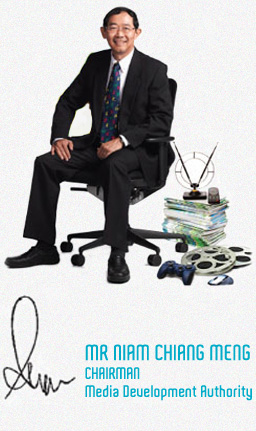The media sector grew at a brisk pace in the year of review. This was in spite of an uncertain economic climate.
In 2010, the media sector1 contributed $6.6 billion2 in nominal value-added,
an increase of 4.8 per cent from 2009.
Employment in the media sector grew 4.4
per cent in the same year, to reach 68,300,
while nominal value-added per worker
increased by 0.4 per cent to $96,600.
While all signs appear positive for now, the rapidly-changing technological landscape and the ensuing impact on the media consumption patterns mean there is no room for complacency. The industry must keep pace, and MDA must evolve our regulatory and industry development approach to stay relevant.
In this regard, MDA rewrote the script in 2011 by overhauling our support schemes to make it easier for media companies
to get the help they need to produce quality content.
From 46 disparate funding schemes previously, the number has been streamlined to just five – Development Assistance; Production Assistance; Marketing Assistance; Talent Assistance and Enterprise Assistance.
Our focus now is on spurring media companies to develop and own their intellectual property, to create engaging and desirable content that will ultimately help the sector move up the value chain and open up a new chapter of growth for Singapore’s media sector.
The response to the change has been encouraging. Since their introduction in September 2011, MDA has supported
300 projects with nearly $6.6 million in grants across the spectrum of the five
new schemes.
While we have fundamentally revamped the way we go about supporting the media industry, MDA’s focus on protecting consumers, as well as building a connected and inclusive society through the media, remains unchanged.
Although the Radio and TV licence has been scrapped, MDA continues its support for Public Service Broadcast programmes (PSB), which are now funded by the government’s tax revenue.
Besides promoting social values and helping to foster a more informed citizenry,
PSB programming on Singapore’s free-to-air broadcast channels gives local media professionals a platform to showcase
their talent.
Last year, MDA funded over 2400 hours of locally-produced PSB programming. Besides entertaining and informing local audiences, some of these programmes are also garnering accolades overseas.
For example, August Pictures Pte Ltd’s The Activist’s Journey – Japan’s Homeless, a look at the poor and destitute in Japan, was a finalist in the Community Portrait category at the New York Festivals – World’s Best TV & Films 2012.
On the consumer protection front, MDA also put in place new rules in November 2011 to prevent consumers from being locked in to excessively long pay-television contracts.
With these rules, the maximum permissible lock-in period is now two years and early-termination charges are also graduated for consumers who have served more than three months of their contracts.
With the explosion of new offerings across mobile, Internet and pay-TV platforms, it is equally important that the MDA continues to give consumers the tools they need to make informed media choices,
and help parents protect their children from undesirable content.
In July 2011, MDA announced plans to make it compulsory for service providers to promote Internet filters when consumers renew or sign up for new broadband contracts. In addition, mobile filters have been introduced as more and more children are now surfing on their smart phones.
The introduction of a new PG13 film rating and the harmonisation of classification guidelines across films, videos and broadcast are among other 2011 milestones for the MDA in the area of consumer protection and empowerment.
This is not the full story of course. There were many other initiatives that MDA embarked on last year beyond its regulatory and industry development charter. On the corporate front, MDA made concerted efforts towards business and service excellence.
In 2011, MDA successfully renewed its Singapore Quality Class (SQC) certification, and continued to leverage on the Singapore Service Class (S-Class) framework and processes to offer
relevant and pro-enterprise service to its customers.
MDA also facilitated lively exchange of views and updates of its initiatives and policies over social media platforms such as Facebook, Twitter and YouTube. Through Care Connexion, a volunteer group formed by its staff, MDA participated in over 2000 hours of community service activities from 2009 to 2011.
In all, the year in review was a good one; with significant and meaningful changes made in the way we used media to better our lives, society and businesses.
I am confident that these positive changes
will become even more impactful come
1 November 2012, when the Ministry of
Information, Communications and the
Arts sharpens its focus on the media,
design and infocomm sectors under a
new name - Ministry of Communications
and Information.
I would like to take this opportunity to thank MDA’s board members, industry partners and especially our hardworking staff for their dedication and support in helping to create a brighter future for Singapore’s
media sector.

